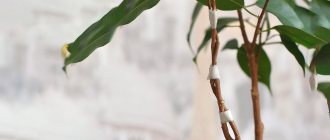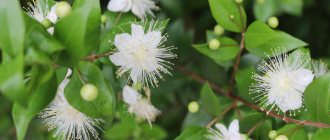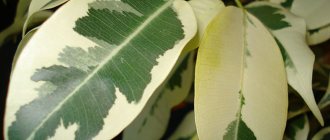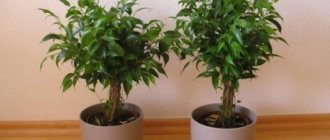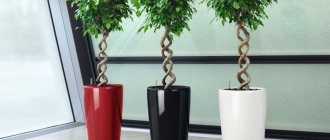Ficus benjamina are popular indoor plants, characterized by a high growth rate and expansion of leaf mass. Therefore, they are favorite objects for the formation of small indoor trees with a crown of various shapes.
Growing decorative ficus is not at all difficult. By regularly carrying out its formative pruning, you can get a beautiful tub plant and even a tree grown in the “bonsai” style.
In the article you will learn everything about forming the crown and trunk of Ficus Benjamin at home, as well as about pruning and pinching the plant.
Basic rules for pruning
Formative pruning of Ficus Benjamin is carried out in early spring, at the end of March or beginning of April. Before active growth begins, there is enough time for the cuttings to heal and for the plant to recover from the resulting stress.
To perform pruning, you will need garden pruning shears, charcoal or activated carbon, a clean cloth and a disinfectant (alcohol or potassium permanganate solution).
Before the procedure, you need to disinfect the pruning shears with alcohol or a solution of potassium permanganate to prevent any infection and the development of the disease.
Thick branches are cut at an angle as close to the bud as possible. Thin shoots are cut above the bud, shortening them by 1/3.
After pruning, wipe the cut areas of thick branches with a clean napkin to remove the milky sap that flows out. Then the sections are covered with crushed charcoal or activated carbon.
Sections of thin shoots do not need to be processed, but it is better to remove the sap that flows out, as it may leave white spots on the leaves of the plant.
In addition to shaping, there is also sanitary and rejuvenating pruning of ficus Benjamin. Let's look at how to shape a ficus benjamina.
Lack of moisture
Lack of moisture can cause leaf drop because there is no way for nutrients to be absorbed from the soil. And also the process of photosynthesis slows down, and there is a restriction in the movement of cell sap.
For Ficus Benjamin, it is important that watering varies according to the changing seasons. In spring and summer, more moisture is required than with the onset of autumn and winter. Then watering should be reduced.
From time to time, use a fork or toothpick to gently loosen the surface of the soil in the flower pot, being careful not to injure the root system. This will allow the soil to stay moist longer and not dry out.
Sanitary pruning
Sanitary pruning of the plant can be carried out not only in the spring, but also at any other time of the year if necessary. It consists of removing dry, diseased and poorly developed shoots.
Dry branches must be removed as they look unsightly . They are also removed for safety reasons: sometimes dry branches become sources of various fungal infections.
If any ficus disease occurs, the affected areas of the shoots are cut off and burned. To do this, you should not wait for spring; such pruning is carried out as soon as possible.
Poorly developed shoots are removed because they are not very decorative. They also increase the density of the crown, preventing light from entering it.
Leaves turn yellow and fall off
Sometimes suddenly Ficus benjamina drops its leaves, which first turn yellow. The most common reason for plant defoliation is a decrease in the amount of light that individual leaves do not receive. They are in the shade. They are blocked from the light by other foliage. What to do about this and what actions to take, you ask?
Rotate the pot 90° throughout the day. This technique helps the plant feel good and not shed its leaves. In winter, additional lighting with a fluorescent lamp will not hurt.
Ficus Benjamin's leaves turn yellow and fall off for other reasons as well. For example, gradual cooling over a period of days or weeks usually does not present any particular problem, but exposure to sudden drafts or cold causes the symptoms we are talking about now.
See also: Care and cultivation of fuchsia at home
So, keep your ficus away from open windows and doors, including air conditioners and heaters. In winter, use a humidifier.
Improper watering is another common reason why leaves fall. Watering should be done as needed, and not on a schedule when the top layer of soil becomes dry, but not overdried. Good drainage will help protect the plant from root rot, which also causes leaves to turn yellow and fall off.
Finally, the last two reasons for yellowing and falling leaves are pests and fungus. Fungicides are used to treat the fungus, and pests are eliminated using insecticide preparations.
Anti-aging pruning
This type of pruning is carried out to restore the decorative appearance of very old ficus plants or plants whose shoots have lost their viability for one reason or another.
Sometimes, when the soil dries out strongly and for a long time, almost all the branches of the tree dry out . In this case, the ficus should not be thrown away; you need to carry out anti-aging pruning.
This procedure is carried out in early spring before the growing season begins. All dead branches are cut out, and living ones are shortened by half. Moreover, not only the main shoots are cut off, but also shoots of the second order. All sections are carefully sprinkled with activated carbon.
When the crown is completely dry, Ficus Benjamin can be trimmed “to a stump” by removing all branches and trimming the trunk. The remaining stump should be no higher than 7-10 cm. Gradually, the plant will restore the crown, growing new young shoots.
About signs and superstitions
There are contradictory signs and superstitions about Ficus Benjamin. Some people do not want him growing up in their home, as his presence can cause scandals, envy or negative talk. Others, on the contrary, believe that the plant rewards their family and home with prosperity, good luck and a calm family atmosphere, plus it helps to add a new member to the family, a small child.
But in order for all good dreams to come true, the plant must be cared for in such a way that it grows well and does not become capricious. By the way, people say that what a person believes in is what he gets. Place a ficus in the bedroom, perhaps it will help you conceive, and on the windowsill in the kitchen it will attract money into the house so that the family always has food.
Regardless of all the signs and superstitions about ficus, the plant purifies the air in the apartment and absorbs harmful fumes that fill our homes after renovation or purchasing furniture, and this is its primary advantage.
Bush
To form a bush, both low-growing and tall ficuses are used. Small-leaved varieties are very popular: they make the bush more lush. To quickly form a bush crown, 2-3 cuttings are simultaneously planted in a pot close to each other.
After planting, as soon as the rooted cutting 15 cm high begins to grow, it is pinched from above, leaving at least 5 leaves.
This stimulates the growth of 4-5 side shoots. When the side shoots reach a length of 10-15 cm, their tops are also cut off .
In this case, the remaining upper buds should be directed not inside the crown, but outward. All sections should be wiped with a napkin to remove white juice and sprinkled with activated carbon.
After the second pruning, when the shoots of the third level reach a length of 10-15 cm, a fairly dense bush is obtained. If the bush is very dense, you can cut 2-3 branches from the middle of the bush and thin it out.
When growing a bush crown, you need to illuminate the plant evenly or periodically turn it to the light in different directions so that the shoots grow evenly.
What problems may arise
When carrying out the crown formation procedure, the following problems may arise:
- An untreated pruning tool (knife) or untreated cuts can cause infection.
- You should not make the crown too thick, as the branches will shade each other and the leaves will begin to die off.
- There is no need to fix the ficus to direct growth immediately after transplantation; you need to wait 3 weeks to allow the plant to get stronger.
- If you use thin wire, be sure to place a piece of fabric under it.
- It is better to use softer materials for molding. For example, tie branches with a rope or twine to a support.
- If the crown has not developed as you intended, then it is recommended that the adult plant be vaccinated.
- If the growth of shoots is one-sided, you can resort to coring - a special cut in the bark above the shoot you need to stimulate its growth.
- If a branch grows in the wrong direction, then weights and guides can be used to give the desired direction.
By taking the time to properly trim and shape Ficus Benjamin, you can grow very interesting and decorative forms.
Stamb
Standard crowns are forms with a pronounced trunk. To grow a trunk, a single cutting is planted. During its growth, all the resulting lower side shoots are removed, leaving 3-4 upper ones.
If you want to grow a standard tree 50 cm high, then the length of the lower part of the trunk without branches should be 15-20 cm.
Typically, desktop specimens have a height of up to 50 cm, and floor-standing ones are much higher: 90-100 cm.
After the lower part of the trunk is formed, they begin to build up the crown. When the plant reaches the desired height, the top shoot is cut off by 5-10 cm.
After this, the side shoots begin to grow intensively. They should be left only within the crown. If they form in the lower part of the plant on the trunk, they must be removed.
Next, the crown is formed in the same way as a bush. When pruning, the outer buds should be directed outward. Don't forget to treat the cuts with activated carbon.
The standard ficus crown can be given various shapes . The spherical crown is very popular and beautiful, but the oval shape, extended upward or to the sides, is no less decorative. When creating a crown in the shape of a ball, you need to leave shoots of the same length when pruning.
Kinds
If you want to have an authentic decoration for your room and create a special atmosphere, then you should definitely buy Ficus Benjamin. Low-growing species look great on window sills, and on the floor in the corners of rooms or offices - tall plants that grow up to two meters high in rooms. There are several popular types of such plants:
- Starlight (starlight);
- Ficus Benjamin Kinki;
- Hawaii;
- Naked;
- Golden King;
- Ficus Benjamin Natasha;
- Baroque;
- Exotic.
All the types of ficus benjamina photos that you see have one thing in common - they look like a weeping tree. The difference lies in the shape and color of the leaves. For example, the Benjamin variety Ficus Baroque has leaves twisted in a spiral. Naked - narrow and elongated. Exotic - with a wavy edge. All types of ficus have ovoid leaves with a long, drip-like point. Variegated species differ from green ones by light spots or thin stripes.
Tiered standard
Tiered trunk is a form of tree with a crown divided into parts. Between its tiers there remains a bare trunk without branches. Such a tree can have 2 or more tiers.
Sometimes tiers are built up gradually . First, a regular standard tree with a round or oval crown is formed. Then pruning is carried out in such a way that the central shoot grows upward.
Gradually, it will be possible to form a continuation of the trunk, and then a new tier of the crown. This is the longest process of forming a longline trunk.
It is much faster to plant 2 cuttings at once and fasten their trunks with wire. Gradually, below they will grow together into a single trunk. The plants will be separated at the top.
Each of them can be grown as a regular standard, but their crowns will be at different heights. If you plant cuttings with different leaf colors, you can get a very beautiful tree with different colors of the crown tiers.
A tiered trunk can be grown from one cutting . It should grow upward, forming an elongated tall single trunk. After the formation of the lower part of the trunk, its crown must be divided into 3 parts.
The lower and upper parts will be two tiers of the trunk, the central part will be the bare trunk located between them. In the center, all side shoots are removed and the top of the tree is pinched. The tiers are formed like a regular single trunk.
Diseases of ficus rubber
With proper care, ficus has strong immunity to various diseases and pests. The main diseases of rubber ficus are attacks by scale insects, spider mites and mealybugs. If you find one of these pests on your plant, you must immediately bathe it in the shower and treat it with appropriate preparations, which are available at any garden store or veterinary pharmacy.
Very often, yellowing, curling and falling of ficus leaves are mistakenly attributed to fungal diseases. In fact, the reason lies in errors in care - too low or high temperature, excess or lack of moisture, lack of light and beneficial microelements in the soil, strong drafts. Only a white coating on the leaves indicates a fungus - powdery mildew. Then the diseased leaves are removed and the flower is treated with a fungicide.
Ficus rubber fits perfectly into any home and office interior. Giant specimens decorate various shopping and business centers, galleries, train stations and airports. Due to its ease of care and decorative qualities, the flower is recommended to be grown even by novice gardeners. And by following the care instructions, you will get a chic green decoration for your home.
Bonsai
Almost all varieties of ficus benjamina can be used for growing bonsai. But the Viandi variety is most suitable for this purpose. It is characterized by a low growth rate and a wavy, curved trunk. From cuttings of this variety you can grow a bonsai the fastest.
The technology for growing these dwarf trees for Ficus Benjamin and for other species is practically the same. Bonsai are grown in low, wide containers filled with depleted soil, which promotes a slow growth rate. The roots of the tree are pruned 2-3 times a year, after which it is planted in the same container. The plant is also pruned 2-3 times a year.
In addition to pruning, great importance is attached to the formation of the trunk and branches.
The branches and trunk are wrapped with thick copper wire, and then gradually bent so that the plant takes on the desired shape . Usually after such procedures, after 4-5 years the plant looks like a real tree in miniature.
How to direct the branches in the right direction?
If you are growing a young Ficus Benjamin, the formation of the crown will require not only the timely removal of apical buds, but also pruning of the side shoots. It happens that pruning greatly exposes the crown of the tree, then it is better to refuse it. It's easier to point the branch in the right direction. Stiff wire is suitable for this purpose. It is wrapped around the protruding process and bent in the desired direction. If the branches inside the crown cross each other unattractively, you can straighten them by using a wooden spacer.
Sculpture
It is very difficult to grow a crown in the form of a sculpture; work on it takes a long time.
Only an experienced gardener can create a tree in the shape of an animal or bird. It is easier to make the crown in the form of a geometric figure - a cone or cylinder. Even the formation of a simple geometric crown takes several years.
In this case, it is necessary to prune the plant annually in the spring, cutting off the branches so that the crown takes on the desired shape.
Usually the branches directed outward are left, and the crowns growing deeper are cut out.
At the same time, the outer part of the crown branches out greatly, so it becomes easier to give it the desired shape.
Necessary tools
You will need a sharp pruner or knife. The branches at the base can be carefully trimmed with small nail scissors, since the pruning shears are very bulky and will be inconvenient for them to operate. An alternative to scissors is a utility knife. Its blade is very sharp. Regular scissors can handle thin branches.
Before starting the procedure, all equipment must be thoroughly disinfected so as not to introduce pathogenic bacteria into the wounds of the tree. Any alcohol solution or potassium permanganate diluted in water is suitable for processing the blades of knives, pruners, and scissors. You can also heat the tools over a fire.
In addition, you will need a sterile napkin to blot the plant juice on the cuts, activated carbon and gloves.

